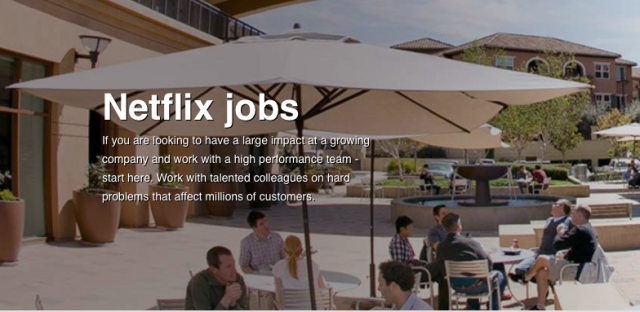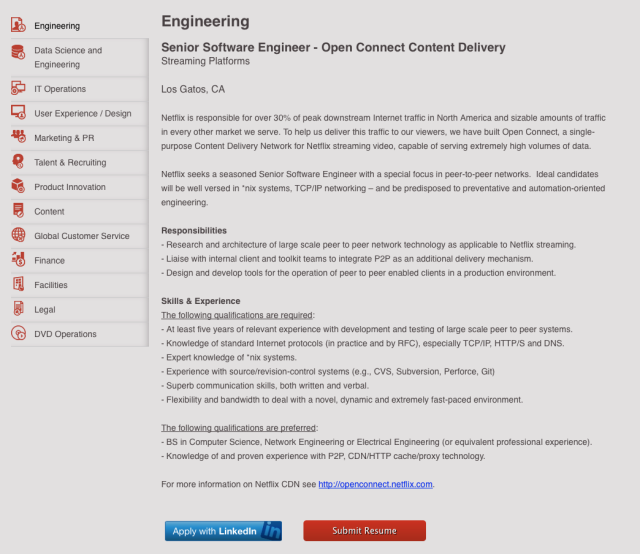
When we wrote about the possibility of Netflix using a peer-to-peer architecture for streaming earlier today, it seemed like more of a thought experiment than a real possibility.
But it turns out Netflix is looking for an engineer to research this very type of system. By searching Netflix job postings we found an opening for a senior software engineer who would work on Netflix's Open Connect content delivery network while researching how P2P technology could be used for streaming.
"Netflix seeks a seasoned Senior Software Engineer with a special focus in peer-to-peer networks," the listing says. Responsibilities include:
- Research and architecture of large-scale peer-to-peer network technology as applicable to Netflix streaming.
- Liaise with internal client and toolkit teams to integrate P2P as an additional delivery mechanism.
- Design and develop tools for the operation of peer-to-peer enabled clients in a production environment.
The successful applicant is required to have "At least five years of relevant experience with development and testing of large-scale peer-to-peer systems." Preferred qualifications include "Knowledge of and proven experience with P2P, CDN/HTTP cache/proxy technology."

The job posting appears to be at least a month old. When asked whether the company intends to stream video using P2P, a Netflix spokesperson replied only that "the best way to see it is that we look at all kinds of routes."
Our story this morning was spurred by a blog post written by BitTorrent, Inc. CEO Eric Klinker, who argued that a peer-to-peer architecture would help Netflix deliver its traffic without having to pay Internet service providers. We spoke with Klinker this afternoon, and he expanded on his thoughts.
"Netflix has a hard time getting traffic onto these networks. It's because they are in a hub-and-spoke model where the traffic flows in only one direction, from Netflix to the consumer," Klinker told Ars.
Netflix is paying Comcast for a direct connection to its network, even though it claims it should be eligible for "settlement-free peering," an exchange of traffic without money changing hands. Comcast (and other ISPs) say Netflix should pay up, since the video streaming company sends more traffic to consumers than vice versa."The foundation for settlement-free peering is you need something resembling a balance [in traffic]," Klinker said. "If you could make Netflix traffic look more like that, then you would have an opportunity to ride the same settlement-free economics that all the Tier 1 ISPs use to connect with each other."
Netflix CEO Reed Hastings himself has made the same point, writing that the company has asked ISPs "if we too would qualify for no-fee interconnect if we changed our service to upload as much data as we download—thus filling their upstream networks and nearly doubling our total traffic."
Given Netflix's job posting, that may be something the company is seriously considering.
Netflix, via torrents
Klinker stressed that his own idea is just a thought experiment and that he hasn't talked to Netflix on this topic. However, we asked him to describe how the system he envisions would work.
"I think you could use torrent technology in ways that provided a different user experience than torrents do today," Klinker said. "You could integrate torrents into something that looks exactly like Netflix today. It could even be a hybrid solution… [where] they would begin to stream from servers, but over time if the content were particularly popular most of that load could be picked up by peers around their customer base."
This wouldn't be entirely unprecedented. The Vudu video service used peer-to-peer technology when it launched in 2007.
Movies would be downloaded by customers if Netflix adopted such a model, Klinker said. Naturally, that would raise concerns about copyright and piracy. "I would imagine the rights holders for the content would insist on some basic locking technologies," Klinker said. Movies or TV shows could be downloaded by consumers even before they became available to the general public, so it could be "living on my storage ready to go once that release date comes and the technology unlocks it," he said.
This wouldn't necessarily make it easier to copy and redistribute Netflix movies to non-subscribers, he argued, noting that shows like House of Cards are already pirated. "Is there a foolproof way to lock content? No there isn't, and even Netflix isn't one," he said.
Klinker pointed to a technology that his company developed a few years ago called BitTorrent DNA as a possible model for Netflix.
"For content companies that wanted to integrate a hybrid hub-and-spoke and peer-to-peer solution, the consumers would access the content on the servers first and begin to get the streams flowing from Netflix servers," he said. "But quickly the peer-to-peer components would kick in and determine how available the underlying content was throughout the peer network and then the clients would regulate how much came from the servers and how much came from other peers based on that availability. There's a lot of intelligence that was built into the edge of this network [in BitTorrent DNA] that did all that balancing and regulation and filling the buffer and keeping the playback smooth."
Consumers would need to have control over whether they participate and how much they download, in part because they might need to be mindful of data caps imposed by their ISPs.
We asked Klinker why consumers would want to help a multi-billion-dollar company like Netflix reduce its costs, and he noted that Netflix could pass on benefits with lower prices and better quality. "The consumer could see value just in a better experience or Netflix could share in the value of this solution to consumers. In other words it could be a discount on their subscription," he said.
The system would have to adapt to all the different devices consumers own. While a desktop or laptop and some gaming consoles could store video, plenty of other devices that connect to Netflix cannot.
"Over time you could integrate storage into the Rokus and the Apple TVs," Klinker said. "I would expect Netflix to take a very broad approach to the market where they would simply have the technology and make it available for devices that have storage."
While Netflix could sell its own hardware to solve the storage problem, Klinker said, "I wouldn't expect they would do that. I think their approach to the consumer electronics market is the right one, where they integrate and license their technology to all players and that way they get broad market adoption."
Theoretically, BitTorrent could help Netflix with building a peer-to-peer system, but Klinker said there haven't been any discussions along those lines. "We have done licensing deals in the past. It's not our core business, which today is largely focused on enterprise applications like BitTorrent Sync and our consumer clients," he said.
reader comments
100